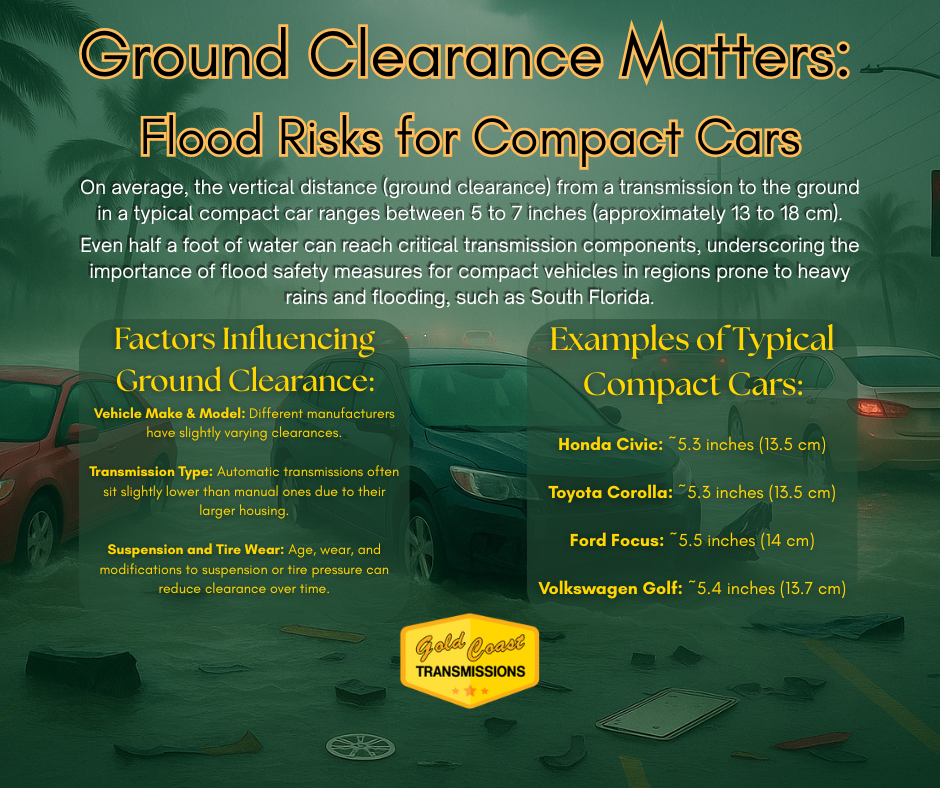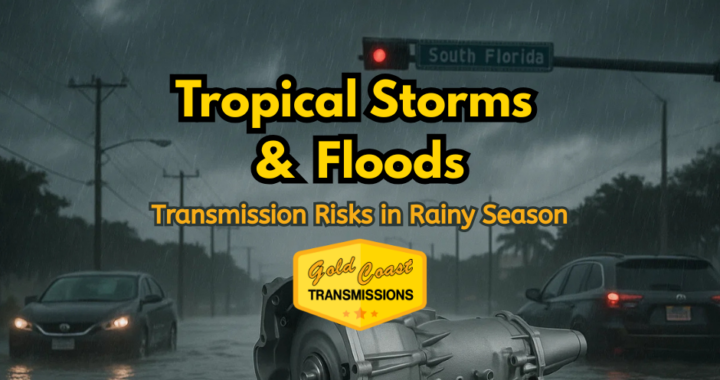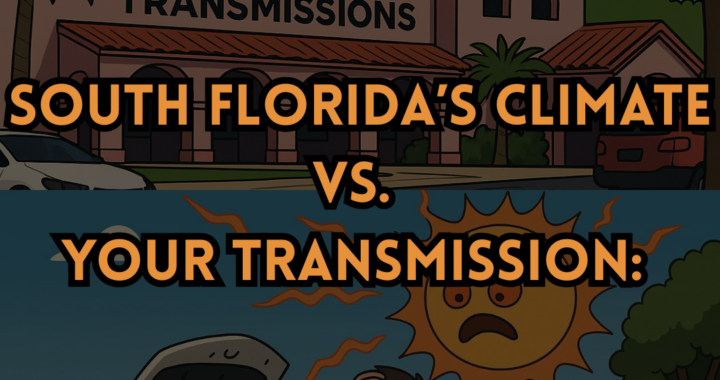As the 2025 hurricane season looms, South Florida drivers should prepare for heavy rainfall and flash flooding. Flooding is a serious hazard – experts note it is “the second-deadliest weather hazard” after heat, and many flood-related deaths happen when drivers try to cross high water. Even a few inches of water can put you at risk. Just six inches of moving water can knock over an adult, and a foot can sweep away a small car. Beyond the risk to people, floodwater can seriously harm your vehicle, especially the transmission.
How Floodwater Can Damage Your Transmission
Your transmission sits low, containing delicate parts and electronics. Rising floodwater can easily reach the transmission vents and seals. Causing damaging liquid to be sucked inside. Water mixes with the transmission fluid, turning it milky or gray. Even an ounce of water can cause trouble as the fluid loses its lubrication and cooling power.
Transmission experts warn that excess moisture leads to “corrosion inside the transmission” and “fluid dilution”, which reduces lubrication and causes erratic shifting. In short, water contamination can ruin the fluid and cause gears or clutches to slip and shift roughly.
- Fluid contamination: Contaminated fluid can not lubricate parts or transmit power properly, leading to rough or delayed shifting.
- Mechanical corrosion: Water causes friction linings to swell and adhesives to dissolve. Metal parts begin to rust, and moisture may dissolve the clutch-plate glue and form what appears to be “white gummy masses,” likely increasing the need for a transmission rebuild.
- Electrical damage: Modern transmissions use sensors and solenoids. Floodwater can short out wiring and modules. Water intrusion often causes electrical failures – dash lights, Anti-Lock Braking Systems, airbags may malfunction, and corroding wiring and connectors.
- Need for overhaul: Sludge, rust, and mold can form if water sits too long. Among the worst cases, the transmission must be completely overhauled.
Signs of Water Intrusion
Watch for warning signs that floodwater has affected your transmission. Key indicators include:
- Milky or discolored fluid. Normal transmission fluid is clear red/pink. If the fluid (visible on the dipstick or under the car) looks gray, milky, or cloudy, water has likely entered. Discolored fluid may also have particles or sludge.
- Erratic or delayed shifting. If your car hesitates between gears, shifts late, slips out of gear, or shifts unpredictably, the transmission may have fluid contamination or water damage.
- Unusual smells or noises. Contaminated fluid can overheat and give off a burning smell. You might hear grinding, whining, or clunking if parts aren’t lubricated properly.
- Electronic warnings. Water exposure can trigger the check-engine light or transmission fault codes. If dashboard lights or limp-mode activate after flooding, have the car checked.
- Visible water damage. Check for damp carpets or upholstery, a musty odor, or mud under the vehicle – these suggest the cabin and mechanical components got wet.

Steps to Take After Transmission Flood Exposure
If you’ve driven through deep water or your area floods, follow these precautions:
- Don’t start the engine. If your car stalled or was submerged, do NOT turn it on. Running the engine or transmission will circulate water throughout the system, causing more damage. Instead, tow the vehicle to a safe location or shop.
- Check the fluid level and color. Once the car is safe, inspect the transmission fluid via the dipstick. If floodwater rises above the dipstick, assume the transmission is flooded. Even if the level is normal, look at the color. Milky or gray fluid means contamination.
- Inspect other parts. Check for water in the engine bay, on the undercarriage, and in the cabin. Look under the car for water lines above the transmission housing – this helps estimate how deep the water got.
- Get a professional diagnostic. Flood damage isn’t always obvious. Bring your car to Gold Coast Transmissions for a thorough inspection. We can test for leaks, pressure-test the transmission, scan for electronic faults, and ensure all components are OK.
Driving Safely in Storms and Flooded Roads
It’s best to avoid floodwater entirely. As AAA emphasizes, “never take a chance that a flooded road is safe to cross”. If you encounter standing water, turn around and find an alternate route. Remember these safety tips:
- Avoid flooded areas. Even if a puddle looks shallow, don’t risk it. Six inches of moving water can sweep away a car’s traction. It takes just 12 inches to float most sedans. Stay away from low spots, rivers, drainage ditches, or closed roads. (Don’t ignore barricades or road closed signs.)
- Move to higher ground. If a storm warning is out, try to park on elevated ground before flooding begins. Never park near culverts, dip sections, or flood-prone underpasses.
- Drive slowly and defensively. In heavy rain, slow down, keep a safe distance from other vehicles, and avoid using cruise control. Turn on headlights, brake gently, and be alert for hydroplaning. If visibility is poor, pull over until rain eases.
- If trapped or stalled, exit the vehicle. If your car stalls in rising water, abandon it and move to safety immediately. A stalled car can be swept away in seconds. Your life is more important than the vehicle.
Protect Your Transmission with Gold Coast Transmissions
Our certified technicians can check your transmission fluid and seals, test electrical systems, and advise you on any issues. If heavy rain or flooding does occur, we’re ready with repairs and towing: from full diagnostics to complete rebuilds. With South Florida’s rainy season ahead, remember that Gold Coast Transmissions is here to restore the heart of your car.



